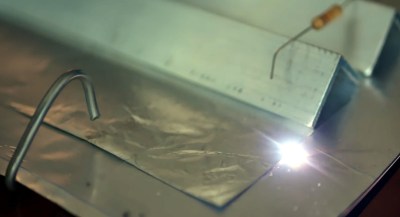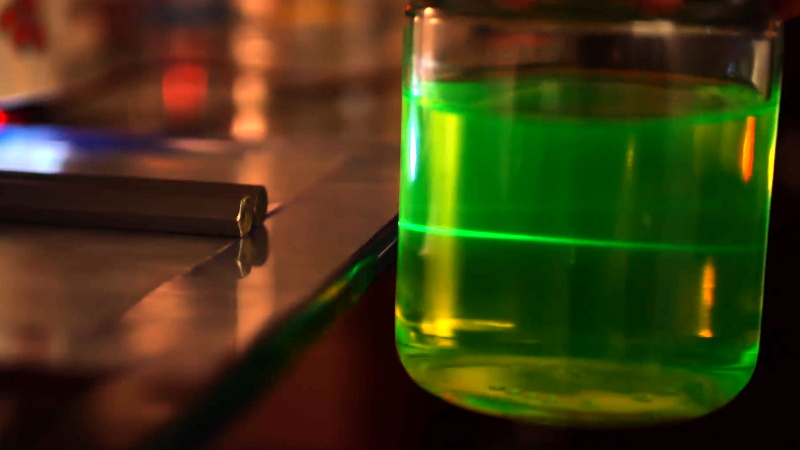Normally, we think of lasers as pretty complex and fairly intimidating devices: big glass tubes filled with gas, carefully aligned mirrors, cooling water to keep the whole thing from melting itself, that sort of thing. Let’s not even get started on the black magic happening inside of a solid state laser. But as [Jay Bowles] shows in his latest Plasma Channel video, building a laser from scratch isn’t actually as difficult as you might think. Though it’s certainly not easy, either.
The transversely excited atmospheric (TEA) laser in question uses high voltage passed across a a pair of parallel electrodes to excite the nitrogen in the air at standard atmospheric pressure, so there’s no need for a tube and you don’t have to pull a vacuum. The setup shakes so many UV photons out of the nitrogen that it doesn’t even need any mirrors. In fact, you should be able to get almost all the parts for a TEA laser from the hardware store. For example, the hexagonal electrodes [Jay] ends up using are actually 8 mm hex keys with the ends cut off.

Of course, you’ll need a fair bit of power to get your homebrew laser going. Luckily, [Jay] has been performing most of his recent experiments with an affordable and easy to build high voltage supply made from a TV flyback transformer. He’s already produced a step-by-step video on sourcing the appropriate components and get everything assembled, which is really a must watch if you’re interested in doing HV experimentation on a budget.
But while it might be easy to build a TEA laser in principle, actually getting it to fire reliably is another story entirely. After some fiddling and a few false starts, [Jay] got in contact with noted madman laser enthusiast [StyroPyro], who gave him some advice based on his own TEA laser project. It ended up being a great example of how finicky these devices are, as his build was only a few slight adjustments away from producing a solid beam. Honestly, who would have thought to sand the hex keys with 500 grit paper?
We’ve seen a number of TEA lasers built over the years, ranging from robust professional looking units to delightfully whimsical hand-cranked versions, (from our own [Steven Dufresne]!) but the simple elegance of the one [Jay] has put together makes it the one we’d be most likely to replicate on our own kitchen table.















So, you really don’t use tea in a TEA laser?
B^(
You do use “Transversely Excited Atmospheric” in a nitrogen nitrogen laser.
Next we’ll be told there are no BISCUIT lasers, either.
There are, but they’re misnamed. They’re actually COOKIE lasers.
Perhaps a tannin dye laser is a (potential) thing?
Hey, that’s great! Amazing how simple a laser can be.
It looks like the link under “ranging from robust professional looking units” is the same as that one under “delightfully whimsical hand-cranked versions”. The link to the robust professional unit is missing.
Good catch, fixed.
Couldn’t you use TV transformer for HV and inverter welder for high current?
Eh? You need high voltage and current.
TV transformer is pretty low current really, a microwave transformer would probably be better.
Let’s Lab on youtube also has a lot of videos on TEA lasers like this one: https://youtu.be/AyN1o_3XaTw
So, what is the Steampunk potential of the TEA LASER? Would putting a mirror at one end increase output at the other end?
At least by a factor of two, right? I wonder why we never see these built with additional mirrors… complexity? Yet another bit of tweaky alignment to get just right?
Les Wright’s iterations (like the one featured in the “professional” link above) are amazing though. He cheats by using pure nitrogen — not really cheating — but his adjustment mechanisms and speed-up caps should be adaptable to a free-air build as well.
I’ve played around with these in the past, and I’ll second the comment in the video about them being loud. Zap zap zap!
The gain of a tea laser even using air is such that a mirror isn’t needed.
You might as well reflect the light coming out the back but even in a short bit of medium the gain is such that once lasing starts the rest of the medium lases as hard as it could <= this is a tautology. if the feedback is enough that a short laser can be made without mirrors then by definition you don't need any more feedback?
Mirrors are important in short mirrors or to filter the output, but most DIY lasers are on the long end and use high gain media so the mirrors tend not to even need aligning.
I recall maybe correctly that with the spark gap in one corner of the capacitor, the discharge in the laser gap will travel from one end to the other and, well, that is probably one of the myths.
OTOH, he has a resistor where the original designs have a simple bit of slinky sized inductor to allow faster charging and choke off flow on the discharge.
Lasers are the kind of topic that keeps getting watered down by analogy and rules of thumb until it can be almost nonsensicle.
But what you say does make sense to me…
Ultimately as StyroPyro says if the lifetime of the excited state is the order of only nano seconds the lack of function might be more due low repetition (and short pulses) which a mirror will not help much with.
I’d imagine an angled gap would spread smear the pulses before there is a plasma to discharge the cap i.e it would indeed help?
The excited state lasts for about 1 ns, at the speed of light that’s about 1 foot of travel. By the time the light runs to the end of the spark gap and bounces off the mirror, the excited state is over. You don’t get multiple passes of amplification like you do with other lasers.
You would get 2 pulses out – one directly from the spark and one reflected from the other end, but you could just as easily grab both of those and combine them outside the laser.
That’s twice the luminance though (twice the photons?), so might be useful.
My favorite part of Steven Dufresne’s TEA laser was him essentially proving a UV laser could be done with 1800s technology!
Absolutely awesome! I have played with TV High voltage circuits for many years and even a special purpose built UV Laser built at Berkeley Labs — sealed container, pure nitrogen, high voltage equals laser. I loved the simple, everyday item approach to make this!!!! Will try to build one and then step it up.
I think this would be more accurately described as an Amplified Spontaneous Emission (ASE) light source than a laser. I would love to build one and measure the linewidth and coherence length of the emitted light! I wonder if adding a couple of mirrors would be enough to turn it into a proper laser…
It’s a real laser. It’s a superluminal three-state laser, so it’s directly stimulated and too fast to make good use of mirrors. (And the medium gain is so high it saturates anyway, so it’s not like you get multiple passes.) Coherence is a function of the aspect ratio of the electrode length and gap. Pulses are about a nanosecond long.
Superluminal?
Sounds like I need to do some reading on this particular system. I would have thought that without feedback from a cavity, it would be impossible to enforce phase coherence across the gain medium since there is no coupling to a cavity mode to provide a stable phase. So I would expect the output to be an overlap of several pulses (each from a different spontaneous “seed” photon) which are not coherent with respect to each other.
But if I properly understand what you are saying, the ratio of spontaneous emission lifetime to the time that the gain medium is in the inversion regime is high enough that only on average, only one seed photon will get amplified and completely deplete the excited states, so that each pulse is entirely self-coherent? Similar to a Q-switched laser? Though obviously different pulses would not be coherent with each other as in a modelocked laser.
Lasers are very neat. I built a TEA nitrogen laser in College and used a Nitrogen laser at 337.1 nm in Photonics to measure the spectra and absorption of several chemicals. Cobalt chloride salt 10 g in 100 ml, 5 g copper sulfate in 100 ml, ethanol, 1 ml of 1 mole per L Hydrochloric acid (had to beg the teacher to use it), Ethylene glycol, etc. I made a crude UV spectrometer. I tested 10 chemicals but this was 15 years ago. The Nitrogen laser i build was an adjustable 1 W we had a 2 W adjustable one too in the Lab.